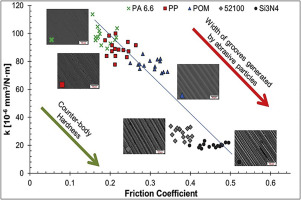Our official English website, www.x-mol.net, welcomes your feedback! (Note: you will need to create a separate account there.)
Influence of the ball material on friction and wear in microabrasion tests
Wear ( IF 5 ) Pub Date : 2020-06-01 , DOI: 10.1016/j.wear.2020.203266 M.A.N. Ardila , H.L. Costa , J.D.B. de Mello
Wear ( IF 5 ) Pub Date : 2020-06-01 , DOI: 10.1016/j.wear.2020.203266 M.A.N. Ardila , H.L. Costa , J.D.B. de Mello

|
Abstract This work aims to contribute to the understanding of the complex relationship between ball material, friction, particle dynamics and wear during microabrasion tests. For that, five different balls (O 25.4 mm) were used: one ceramic (Si3N4), one metal (AISI 52100 steel) and three thermoplastic polymers (polypropylene, polyacetal, and polyamide 6.6). The tests used a fixed ball micro-abrasion test rig, AISI 304 austenitic stainless steel specimens, silica abrasive particles (10 %wt. slurry concentration), rotational speed of 150 rpm and total test time of 90 min. The harder balls induced higher friction but resulted in lower wear rates than the softer polymeric balls. The wear craters showed that particle entrainment was favoured for the low friction, softer balls (polypropylene and polyamide 6.6), leading to sliding of the abrasives and thus grooving. The craters produced with the harder balls (AISI 52100 steel and Si3N4) presented a few, sparsely spaced deep grooves, but with significant amount of microindentations between the grooves, characterizing the mechanism of microrolling. The polyacetal ball resulted in intermediate results between the other two groups. It was hypothesised that for the lower friction materials the larger difference in friction between the abrasive and the ball (μab) and between the abrasive and the specimen (μas) favoured particle entrainment and increased wear rates. For the harder balls this difference should be smaller, leading to fewer particles entraining into the contact, but fragmentation of the abrasives could induce microrolling between the grooves.
中文翻译:

在微磨损试验中球材料对摩擦和磨损的影响
摘要 这项工作旨在有助于理解微磨损试验中球材料、摩擦、粒子动力学和磨损之间的复杂关系。为此,使用了五种不同的球 (O 25.4 mm):一种陶瓷 (Si3N4)、一种金属(AISI 52100 钢)和三种热塑性聚合物(聚丙烯、聚缩醛和聚酰胺 6.6)。测试使用固定球微磨损试验台、AISI 304 奥氏体不锈钢试样、二氧化硅磨粒(10%wt. 浆料浓度)、150 rpm 的转速和 90 分钟的总测试时间。与较软的聚合物球相比,较硬的球会产生较高的摩擦,但磨损率较低。磨损坑表明颗粒夹带有利于低摩擦、较软的球(聚丙烯和聚酰胺 6.6),导致磨料滑动,从而导致开槽。用更硬的球(AISI 52100 钢和 Si3N4)产生的陨石坑呈现出一些稀疏间隔的深凹槽,但凹槽之间有大量的微压痕,这是微滚轧机制的特征。聚缩醛球导致其他两组之间的中间结果。假设对于较低摩擦材料,磨料和球之间的摩擦力差异 (μab) 以及磨料和试样之间的摩擦力差异 (μas) 有利于颗粒夹带和磨损率增加。对于较硬的球,这种差异应该更小,从而减少进入接触面的颗粒,但磨料的碎裂可能会导致凹槽之间的微滚。用更硬的球(AISI 52100 钢和 Si3N4)产生的陨石坑呈现出一些稀疏间隔的深凹槽,但凹槽之间有大量的微压痕,这是微滚轧机制的特征。聚缩醛球导致其他两组之间的中间结果。假设对于较低摩擦材料,磨料和球之间的摩擦力差异 (μab) 以及磨料和试样之间的摩擦力差异 (μas) 有利于颗粒夹带和磨损率增加。对于较硬的球,这种差异应该更小,从而减少进入接触面的颗粒,但磨料的碎裂可能会导致凹槽之间的微滚。用更硬的球(AISI 52100 钢和 Si3N4)产生的陨石坑呈现出一些稀疏间隔的深凹槽,但凹槽之间有大量的微压痕,这是微滚轧机制的特征。聚缩醛球导致其他两组之间的中间结果。假设对于较低摩擦材料,磨料和球之间的摩擦力差异 (μab) 以及磨料和试样之间的摩擦力差异 (μas) 有利于颗粒夹带和磨损率增加。对于较硬的球,这种差异应该更小,从而减少进入接触面的颗粒,但磨料的碎裂可能会导致凹槽之间的微滚。但凹槽之间有大量的微压痕,这是微滚轧机制的特征。聚缩醛球导致其他两组之间的中间结果。假设对于较低摩擦材料,磨料和球之间的摩擦力差异 (μab) 以及磨料和样品之间的摩擦力差异 (μas) 有利于颗粒夹带和磨损率增加。对于较硬的球,这种差异应该更小,从而减少进入接触面的颗粒,但磨料的碎裂可能会导致凹槽之间的微滚。但凹槽之间有大量的微压痕,这是微滚轧机制的特征。聚缩醛球导致其他两组之间的中间结果。假设对于较低摩擦材料,磨料和球之间的摩擦力差异 (μab) 以及磨料和试样之间的摩擦力差异 (μas) 有利于颗粒夹带和磨损率增加。对于较硬的球,这种差异应该更小,从而减少进入接触面的颗粒,但磨料的碎裂可能会导致凹槽之间的微滚。假设对于较低摩擦材料,磨料和球之间的摩擦力差异 (μab) 以及磨料和试样之间的摩擦力差异 (μas) 有利于颗粒夹带和磨损率增加。对于较硬的球,这种差异应该更小,从而减少进入接触面的颗粒,但磨料的碎裂可能会导致凹槽之间的微滚。假设对于较低摩擦材料,磨料和球之间的摩擦力差异 (μab) 以及磨料和试样之间的摩擦力差异 (μas) 有利于颗粒夹带和磨损率增加。对于较硬的球,这种差异应该更小,从而减少进入接触面的颗粒,但磨料的碎裂可能会导致凹槽之间的微滚。
更新日期:2020-06-01
中文翻译:

在微磨损试验中球材料对摩擦和磨损的影响
摘要 这项工作旨在有助于理解微磨损试验中球材料、摩擦、粒子动力学和磨损之间的复杂关系。为此,使用了五种不同的球 (O 25.4 mm):一种陶瓷 (Si3N4)、一种金属(AISI 52100 钢)和三种热塑性聚合物(聚丙烯、聚缩醛和聚酰胺 6.6)。测试使用固定球微磨损试验台、AISI 304 奥氏体不锈钢试样、二氧化硅磨粒(10%wt. 浆料浓度)、150 rpm 的转速和 90 分钟的总测试时间。与较软的聚合物球相比,较硬的球会产生较高的摩擦,但磨损率较低。磨损坑表明颗粒夹带有利于低摩擦、较软的球(聚丙烯和聚酰胺 6.6),导致磨料滑动,从而导致开槽。用更硬的球(AISI 52100 钢和 Si3N4)产生的陨石坑呈现出一些稀疏间隔的深凹槽,但凹槽之间有大量的微压痕,这是微滚轧机制的特征。聚缩醛球导致其他两组之间的中间结果。假设对于较低摩擦材料,磨料和球之间的摩擦力差异 (μab) 以及磨料和试样之间的摩擦力差异 (μas) 有利于颗粒夹带和磨损率增加。对于较硬的球,这种差异应该更小,从而减少进入接触面的颗粒,但磨料的碎裂可能会导致凹槽之间的微滚。用更硬的球(AISI 52100 钢和 Si3N4)产生的陨石坑呈现出一些稀疏间隔的深凹槽,但凹槽之间有大量的微压痕,这是微滚轧机制的特征。聚缩醛球导致其他两组之间的中间结果。假设对于较低摩擦材料,磨料和球之间的摩擦力差异 (μab) 以及磨料和试样之间的摩擦力差异 (μas) 有利于颗粒夹带和磨损率增加。对于较硬的球,这种差异应该更小,从而减少进入接触面的颗粒,但磨料的碎裂可能会导致凹槽之间的微滚。用更硬的球(AISI 52100 钢和 Si3N4)产生的陨石坑呈现出一些稀疏间隔的深凹槽,但凹槽之间有大量的微压痕,这是微滚轧机制的特征。聚缩醛球导致其他两组之间的中间结果。假设对于较低摩擦材料,磨料和球之间的摩擦力差异 (μab) 以及磨料和试样之间的摩擦力差异 (μas) 有利于颗粒夹带和磨损率增加。对于较硬的球,这种差异应该更小,从而减少进入接触面的颗粒,但磨料的碎裂可能会导致凹槽之间的微滚。但凹槽之间有大量的微压痕,这是微滚轧机制的特征。聚缩醛球导致其他两组之间的中间结果。假设对于较低摩擦材料,磨料和球之间的摩擦力差异 (μab) 以及磨料和样品之间的摩擦力差异 (μas) 有利于颗粒夹带和磨损率增加。对于较硬的球,这种差异应该更小,从而减少进入接触面的颗粒,但磨料的碎裂可能会导致凹槽之间的微滚。但凹槽之间有大量的微压痕,这是微滚轧机制的特征。聚缩醛球导致其他两组之间的中间结果。假设对于较低摩擦材料,磨料和球之间的摩擦力差异 (μab) 以及磨料和试样之间的摩擦力差异 (μas) 有利于颗粒夹带和磨损率增加。对于较硬的球,这种差异应该更小,从而减少进入接触面的颗粒,但磨料的碎裂可能会导致凹槽之间的微滚。假设对于较低摩擦材料,磨料和球之间的摩擦力差异 (μab) 以及磨料和试样之间的摩擦力差异 (μas) 有利于颗粒夹带和磨损率增加。对于较硬的球,这种差异应该更小,从而减少进入接触面的颗粒,但磨料的碎裂可能会导致凹槽之间的微滚。假设对于较低摩擦材料,磨料和球之间的摩擦力差异 (μab) 以及磨料和试样之间的摩擦力差异 (μas) 有利于颗粒夹带和磨损率增加。对于较硬的球,这种差异应该更小,从而减少进入接触面的颗粒,但磨料的碎裂可能会导致凹槽之间的微滚。



























 京公网安备 11010802027423号
京公网安备 11010802027423号